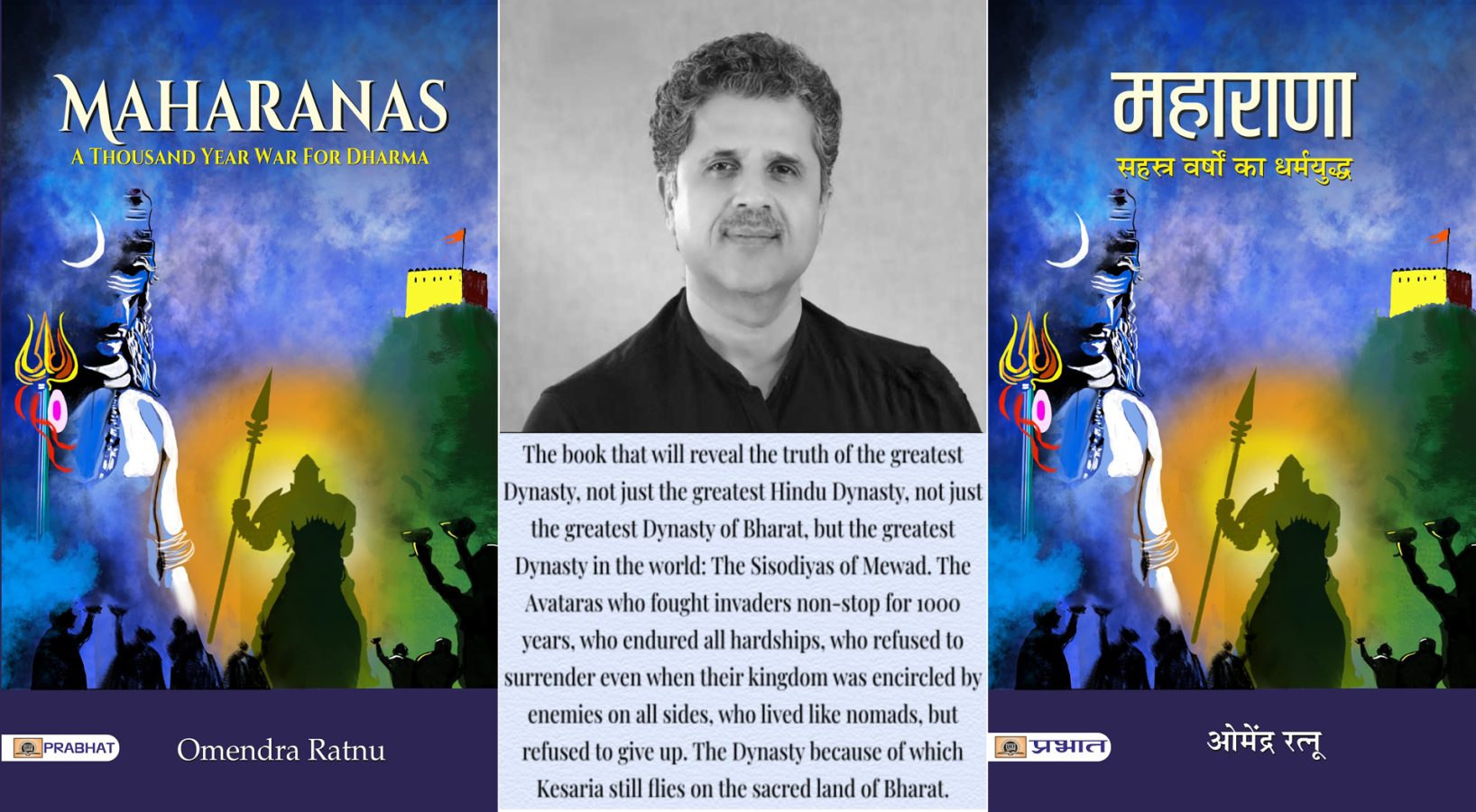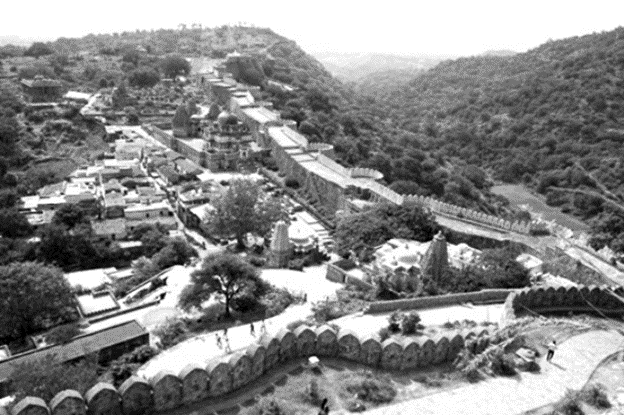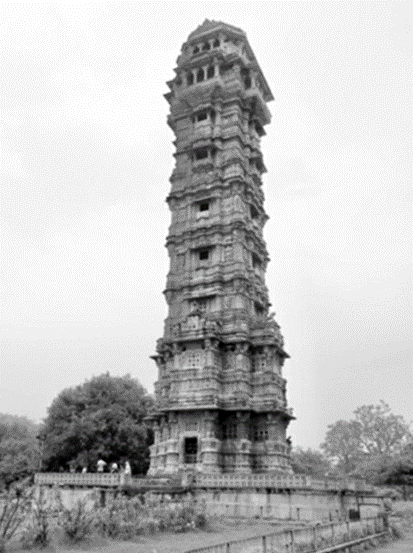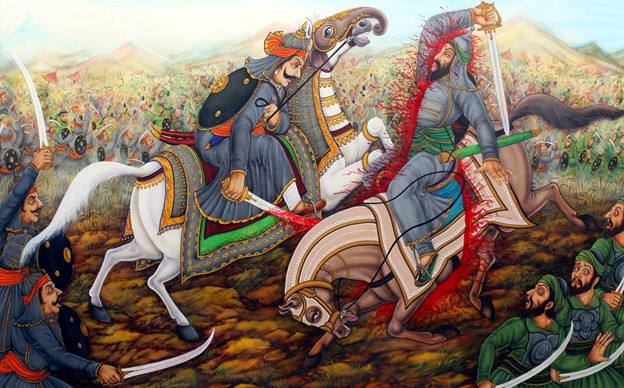Maharanas of Mewar and their thousand-year defense of Hindu society have been kept hidden from the people of Bharat. Average Indians can hardly think of just three names, Chhatrapati Shivaji, Guru Gobind Singh, and Maharana Pratap when we think of resistance to Islamic invasions in India. But all these three people happened to be around the 16-17 Century.
History tells us that the first Islamic attack on Indian soil was led by Mohammad Bin Qasim in 712 AD, who killed King Dahir Sen of Sindh and was soon humiliated and chased away by Bappa Rawal in the 8th century.
However, Indian history books have been wiped clean of the names of King Dahir Sen or Bappa Rawal or any of the Maharanas of Mewar, or any brave Kings who relentlessly fought Islamic invaders to keep them at bay for over 800 years and protected the Hindu motherland from those barbarians.

The post-colonial political powers in India have been in bed with the Leftist- Jihadi cabal who did not wish the people of Bharat to know the truth of the true heroes, the true sons of the soil. They carefully conspired to hide the true history and wrote lies to portray the indigenous Hindu society as a meek and weak society who were always defeated and ruled by superior and more powerful outside forces.
At a time when the Hindu psyche has been consistently polluted with lies about Mughal Sultanate straight through the school system for over 75 years since independence in 1947, Dr. Omendra Ratnu’s ‘Maharanas – A Thousand Year War for Dharma’ is a much-needed anti-virus to protect the Hindu minds from the virus of apathy towards Bharat’s glorious past that fuels the disease of fake secularism and ‘Gandhiwad’ that has plagued the Hindu minds!
Maharanas, A Book That Fills Reader’s Eyes with Tears of Pride and Amazement
I got a Hindi version of the book for myself and the English version for my boys, and we began reading. I finished reading all eighteen chapters of the book in about two and half days, and like many other people who have shared their reading experience on social media, the book did put me into tears more than once.
On the third day of his reading, my younger son came to me after he was done with his fourth chapter (up to the story of the Jauhar of Rani Padmini) and said,
It almost feels like these were some imaginary superhumans….
In his view, the stories of Maharanas, beginning with that of Bappa Rawal, who humiliated an army ten times larger than his own led by Md. Bin Qasim and chased them away from Sindh, all the way to Iran, then the story of the “Jal Jauhar” by Maharana Hammir Singh’s daughter Padmala that shows the willingness to make the supreme sacrifice for freedom, then the story of the rescue operation of Rana Ratan Singh and followed by the Jauhar of Rani Padmini…all of these stories do make one feel like these people were from another world…
Dr. Ranu (the author) himself has said many times in interviews that he found himself in tears throughout the writing of these stories. I wouldn’t lie either, as I found pages in every chapter of this book when I also found myself in tears. The book succeeds in making those scenes alive in our minds as we read that can only be truly understood if we can visualize them. The words in those pages take us right there in that time, and then we feel the emotions they feel…. and so, we cry!
Right from the start, when we read the story of Bappa Rawal, our chests are filled with pride, knowing that we had a Maharana in the 8th century who not only conclusively defeated and humiliated Islamic terrorists but ensured that Bharat remained protected for almost 500 years from that point on from their repeated invasions. That was several hundreds of years, even before Maharana Pratap was even born. That’s such a relief just to find out that Islamists did not rule Bharat and Hindus did not endure slavery for a thousand years like the lies in the history books that have been fed to us from our childhood through the school system.
The book beautifully walks the reader through the journey of a thousand years by our ancestors, starting from Bappa Rawal in the 8th century to Maharana Raj Singh in the 17th century, and everything in between that happened during these thousand years!
The Stories of Maharanas Brings the Truth Leftist Historians Tried to Hide from Us
Like most Indians, I have been blissfully unaware of most of the Mewar’s history throughout my school years. Like everyone who has ready history books in Indian schools, I wouldn’t say I liked the subject anyway. The only thing that I seemed to know and remember was the name of Maharana Pratap, the name of his horse, Chetak, and the battle of Haldi Ghati, about which I didn’t even know who won or lost.
This book, however, has been a tremendous value addition to my knowledge of the glorious history of our great ancestors, whose valor and sacrifices have enabled the survival of Hindu society despite the consistent vicious attacks on our motherland, Bharat, for over a thousand years! Some of the fascinating stories of these Maharanas that I learnt through this book are these:
Just for sharing some of the most impressive stories that my mind caught onto. Let me share a few stories from the book here.
Bappa Rawal – The Conqueror of Arabia
The story of Maharanas begins with Bappa Rawal, the first Maharana who took an army of about 6000 warriors in CE 738 and attacked an army of 60000 barbarians of Arabs led by Md. Bin Qasim in the battle of Rajasthan, routed them completely, killed Junaid Al-Marri and chased Islamic forces all the way to Iran.
The reasons for Bappa Rawal’s attack, the details of that glorious victory, and how he ensured protection for the future for Bharat are narrated beautifully in the book.
The effect of this decisive victory of Bappa Rawal and the arrangements he made since cast a fear in Arabs so deep that Islamic invaders stayed away from India’s borders for almost about 400+ years!
It’s a shame that the leftists-Jihadi historians of India have tried their best to strategically not even let our children know the name of Bappa Rawal through the school system.
Maharana Hammir Singh: Destructor of Tughlaqs
In the 14th century, after Maharana Ratan Singh was killed by Allauddin Khilji and Chittor was taken over by Islamic forces for the first time, every temple and structure of consequence was either desecrated or destroyed by Khilji. But the Rajputs didn’t give up, and nine generations of Ratan Singh continued the struggle to regain Chittor, sometimes winning and losing sometimes.
Then came Maharana Hammir Singh, whose rise to the position of Maharana itself is a tale of amazement. But what is even more fascinating is to read how the total trust the entire population had in their kings back then. Those were the people who loved and respected their Rana enough that they joyously followed their Rana to a life of extreme hardship and adversity for a prolonged period of turbulent times.
Maharana Hammir Singh went through a very rough patch while trying to regain control of Chittor from Mohammad Bin Tughlaq. Then came his time when he attacked Tughlaq’s army, which was 3 to 4 times larger than his own. He not only defeated Tughlaq but took him as a prisoner in the battle of Singoli. Tughlaq, the mighty Mughal Sultan, was kept prisoner like a dog in the ordinary prison of Chittor for over three months, and no one from the ‘Delhi Sultanate’ dared to try to free him from the clutches of Maharana Hammir Singh.
Maharana Hammir ruled uninterruptedly for almost fifty years from that point. He rebuilt Hindu temples all over the region up to Gaya and Banaras and died at a ripe age due to natural causes. He left behind a name revered in Mewar as one of the wisest, most gallant, and invincible kings of Mewar, leaving a well-established and extensive Hindu kingdom to his sons.
Again, thanks to our shameless historians, I never heard of his name throughout my childhood and never read anything about him until this book!
The Story of Maharana Lakshya (Lakha) and Rawal Choonda
Maharana Lakha’s story is that of another powerful ruler who chased away Muslim looters out of Mewar and raised them up to Gaya. Maharana Lakha also strengthened Mewar’s economic might in a way that would fuel Mewar’s fight with Islamic tyrants for generations to come.
But there is a story of his eldest son, Rawal Choonda, who also came to be known as ‘Bhishma of Mewar’ for repeating a similar vow that got Devavrat Bhishma of Mahabharata. In the case of Rawal Choonda, his father, Lakha, ended up marrying the princess, who was ideally supposed to be married to Choonda himself. This fascinating story establishes Rawal Choonda as the man of the highest standards.
Devavrat Bhishma had forsaken his right to rule when faced with a similar predicament and decided not ever to get married. However, Choonda’s sacrifice surpasses that of Bhishma in the sense that Choonda also renounced the right of all his future generations to claim the throne of Chittor. To our amazement, the descendants of Choonda, who are known as ‘Choondawat Rajputs, remained loyal to a promise of their ancestor forever since!
The shameless leftist-jihadi historians never let our children even hear the name of such great heroes of Bharat. The book is filled with stories of such stories of greatness and sacrifice…
Maharana Kumbhakarna Singh (Kumbha): The Invincible Genius
His birth itself is a fascinating story, and the way he was named ‘Kumbhakarna.’ He later came to be known as Maharana Kumbha and went on to become one of the most successful kings of Mewar. His greatness, valor, and organizational success placed him in the same category as Ashoka, Harsha, Samudragupta, or Chandragupta Vikramaditya.
Kumbha fought fifty-six wars in his lifetime and did not lose even one. That makes Kumbha a warrior par excellence and a master strategist who anticipated every move of his enemies and beat them at it.
During his time, Maharana Kumbha, with his vast army, fought a battle with a powerful Sultan, Mahmud Khilji, in CE 1437. Mahmud was not only defeated and chased by Kumbha but was captured and brought to Chittor, where he was also kept prisoner for six months.
Ironically, Kumbha treated this prisoner fairly and then released Mahmud despite knowing what happened to Prithviraj Chauhan when he released Ghori in the 12th century in a similar situation after capturing. This action of Kumbha that costed many lives and many more battles for Kumbha, as you will find out when you read the book.
However, among many battles that Kumbha won, one that was special was when Qutub-ud-din (the ruler of Gujrat) forged an Islamic alliance with Mahmud Khilji (the same prisoner who was released earlier by Kumbha) to jointly attack Mewar simultaneously from two sides to overwhelm and defeat Kumbha at once! To their misfortune, Maharana Kumbha comprehensively defeated them on both the fronts at once and then also attacked them later one by one and gained further ground.
Maharana Kumbha was not just an undefeated warrior king. His architectural prowess was just as magnificent. Of the eighty forts that are spread across the landscape of Mewar today, thirty-two were built by Kumbha alone. Kumbha raised Kumbhalgarh in such a manner that it became an architectural wonder and impregnable to any invading army. Built in the Aravallis at the height of 1,100m (3,600 ft) above sea level, the fort has a perimeter of 36 km, making it one of the longest walls in the world, surpassed only by the Great Wall of China.


Among other architectural works under Maharana Kumbha, he constructed the Vijay Stambha, a nine-story tower to commemorate his victory over Mahmud Khilji of Malwa. Vijay Stambha is an architectural marvel that impresses any modern-day architect too. Made as a tribute to Bhagwan Vishnu, this 122-feet tall tower was completed in CE 1448.
Maharana Sangram Singh (Sanga) – Fierce Servant of Mewar
As the story of the Maharanas progresses, the period of Maharana Sanga is another golden period of Mewar. Sanga comes across as an uninterested party to the throne. Yet he rose to the occasion when he got the responsibility to lead and responded ferociously and wholeheartedly when beckoned to war.
This is the story of a glorious Maharana who defeated the mighty Lodhis of Delhi and numerous other kings and Sultans with his steely resolve, military acumen, and leadership skills of the highest quality seen anywhere. Unfortunately, not many people even know his name today.
Maharana Sanga won many battles, just like his ancestor Maharana Kumbha. One of the most important of his battles was the battle of Khanwa with Babur and his army. But that began with his first skirmish with the Turk-Afghan forces under the leadership of Babur on 21st February 1527 on the north-eastern border of Rajasthan. When Sanga’s armed forces slaughtered 1500 of Babur’s men, they started running away. About that encounter, one of Babur’s generals writes:
The Rajputs have indomitable courage. They are the personification of Azrael (death). Unlike our troops, they do not abandon the field.”
But that skirmish translated into the final battle of Khanwa only weeks later, on 16th March 1527, when Sanga led an army of two lakh against 90,000 Babur powered by the firepower of their cannons which Rajputs had never seen before! It was a bloody battle with many ups and downs that killed almost most of the people from both sides. Sanga survived the battle, and so did Babur. But as Dr. Ranu’s research shows and counters with facts, leftist and Jihadi historians have concluded the battle of Khanwa in favor of Babur, which is a total lie. Maharana Sanga won that battle, as the book proves with many undeniable facts.
Unfortunately, within a year or so from this battle, Maharana Sanga was poisoned when he was still in his late 40s. This untimely murder of Sanga proved to be the downward turning point for Bharat. The Rajput confederation was shaken entirely at that point as Rajputana could never recover from this loss. The Rajputs could not assemble under one roof after Maharana Sanga again for a very long time.
The entire Hindu society suffered the scourge of these murderers for the next 150 years. Mewar got so depleted after Sanga that it could no longer halt the march of Islamic forces into the heart of Bharat. Later on, Mewar witnessed the murderous attack by Bahadur Shah on Chittor when the second Saka-Jauhar happened with Rani Karmawati sacrificing herself with 13,000 other women, and 32,000 Hindu warriors were martyred while defending Chittor. Those were the darker days in Mewar’s history…
Maharana Pratap Against the Cruel Jihadi, Muhammad Jalaluddin Akbar
Maharana Pratap’s name comes to mind when we hear the term ‘Maharana’ in general since that’s the only name we have heard through our school system (just a little) or in folk stories. Even then, the image of Pratap is painted of a poor brave warrior king who struggled his entire life for his honor and, in the end, died without many accomplishments.
Dr. Ratnu himself writes in the book’s preface that he was intrigued to look into the life of Maharana Pratap because of a tweet from Sanjay Dikshit about the battle of Dewair in which Mr. Dikshit claimed that Pratap had won the battle. The author had never heard anything about that battle until that day, after which he began his entire research on Maharanas, and finally, that work resulted in the writing of this book!
Not surprisingly, three chapters of the book are dedicated to the most heroic Maharanas of all, Pratap, who carried the highest principles of morality and honorable conduct on his lone chest all his life. The defining feature of Maharana Pratap’s life and work has been his incessant struggle against the powerful Turk-Mughal invader, Akbar, at one of the weakest points in the history of Mewar.
When you read this book, and especially when you get to know the story of Pratap, you can’t say anything but just nod in agreement with pride when the author says this:
Pratap passed on to us a legacy worth living for, worth fighting for, worth dying for.
The crowning of Pratap as Maharana of Mewar itself is such an inspiring tale that establishes the kind of democratic values that are deeply rooted in the very DNA of Bharat. Then the story of his struggles, his leadership abilities, and the commitment of the people of Mewar towards their Maharana is so unique that it’s impossible to find it anywhere else in any other part of the world’s history.
I just want to quote a few lines from the book that beautifully and truly describes the situation that Pratap had to deal with. This is heart-wrenching to realize what Maharana Pratap was faced with, and it fills us with pride to know that he did not surrender and came out victorious against one of the most vicious enemies of Mewar and Hindus until that point:
Akbar was a cold-blooded murderer who pursued his ambition of Islamising the Indians in the subcontinent with unmatched passion and fervor.
Pratap knew that he alone stood between Akbar and his design of Islamisation of Hindustan.
Pratap knew that without him standing, the Hindus of this great land would be forced to convert or die.
Without a doubt, if we are Hindus today, it is largely due to that one man—Maharana Pratap Singh of Mewar.
This awareness itself should be sufficient for us to raise Pratap to a level of a (great being) and bow our heads in reverence to the amazing resistance that he put up and ☐ took to its logical end, all on his lonely shoulders.
The Battle of Haldighati: The First Win of Pratap against Akbar
There has been a lot of propaganda peddled by the leftist and Jihadi historians to paint Pratap as a loser in this Battle. But when you read this book, you realize that Pratap did not lose this battle, although this was only his first direct and major offensive against Akbar’s might.
The battle was fierce, and Pratap’s army had to incur heavy losses, too, due to a few mistakes on the battlefield. But the result of the battle of Haldighati established Maharana Pratap Singh of Mewar as the unquestioned leader of Hindus. Both Pratap and Akbar realized that the Mughals had no answer to the mountain warfare of the Sisodias and their army. As a result of this battle, other Hindu kings finally found a leader they could trust and rally behind who could stand against evil Akbar! This created Hindu unity in the region.
The Battle of Dewair: The Decisive and Conclusive Defeat of Akbar
The real conclusive and comprehensive victory of Maharana Pratap materialized in the battle of Dewair on the Vijayadashmi 16th of September 1583, when Pratap’s army attacked the Mughal army from three sides and started slaughtering the enemy mercilessly.
This was the legendary battle when Pratap attacked the Mughal commander, Bahlol Khan, with his sword, which sliced the Uzbek from the head to his midriff. Pratap’s attack was so fierce that his mighty blade not only sliced Bahlol in two parts, but it went ahead and sliced his horse from the middle as well. The picture below shows what happened at that moment.

Hundreds of soldiers fighting on the scene watched this spectacular sight in utter amazement and awe. It was as though all fury of Hindu retribution against sins was visited by Pratap in that single blow.
Dr. Ratnu has beautifully summarized that blow by Maharana Pratap in these lines, and I quote:
The silent surrender of Maharani Padmini to the flames of Saka, the deceitful murder of Rana Ratan Singh, the treachery against Pratap’s grandfather Rana Sanga at Khanwa, the slaughter of Hindus at the third Saka of Chittor, the decades of suffering, of roaming in the Aravallis, the pain of losing friends and family at Haldighati, all converged at that singular point of conflict between Hindus and Muslims of the region.
Pratap did not merely slay a Mughal General on that day but sent a message to the whole world that this was the terrible form Hindu fury would assume when it manifested out of the deep desire for freedom. Such Hindu fury is also entirely capable of unthinkable vengeance. Nowhere in the recorded history of humankind has such a battlefield feat been recorded.
Rana Pratap did not merely avenge Haldighati that day but cleaved open the entire edifice of deceit and cowardice that Akbar had so laboriously built to subjugate the Hindus.
From that day in 1583 to the day of his in January 1597, no warrior of any significance ever engaged Pratap in one-to-one combat. No wonder that after this day, Akbar kept pleading with his Generals to invade Mewar, but none ventured to do so. Such was the intensity of the assault on the Mughals that day that all thanas around Mewar were vacated overnight.
His character, valor, and determination are such that just reading about him fills us with tears of joy that fills our eyes with emotions of pride and gratitude in our heart. This book is a tribute to our brave ancestors because of whom we are still a 100-crore thriving Hindu population in Bharat and around the world.
The Story of Maharana Amar Singh and Karan Singh and His Lifelong Struggle with Mughals
After Maharana Pratap died early because of an accident during a hunting trip, the control and the Mewar’s conflict with Mughals fell on the able shoulders of Maharana Amar Singh, his son, who was a very noble, brave, and committed Maharana true to the legacy of his ancestors who fought countless battles with Akbar and his decedents and went through many hardships.
After many decades of armed conflict, when Mughals and Rajputs both sides were tired and exhausted, a time came when Jahangir and Maharana Karan Singh (Amar Singh’s son) established a truce treaty that was a sage move considering that Mewar really needed a break to rest, regroup and rebuild its energy and fortify Mewar for the final and decisive battle against Aurangzeb that would come under the leadership of Maharana Raj Singh, the great-grandson of Maharana Amar Singh.
Maharana Raj Singh Who Resolutely Defeated Aurangzeb
Maharana Raj Singh was the last of the Maharanas Dr. Ratnu has captured in this book. The thousand-year glorious struggle of Maharanas ends with the decisive and permanent victory of Maharana Raj Singh against Aurangzeb and Mughals.
Raj Singh inherited a prosperous and rejuvenated Mewar from his father, Jagat Singh, and was crowned the Maharana of Mewar on 22nd October CE 1652. For the next twenty-eight years till his death, Raj Singh changed the course of Hindu history in the subcontinent irreversibly, and let me discuss a couple of his most notable feats.
Raj Singh and Princess Charumati Marriage Story
Maharana Raj Singh’s marriage with Kishangarh’s princess, Charumati, reminds us of the marriage of Shri Krishna with Rukmini in Mahabharata. While Shishupal and Jarasandh were the villains in the case of Princess Rukmini, here, Aurangzeb was in the role of Shishupal.
This saga of saving Charumati is a thriller, material for a great spectacular movie someday, showing the kind of sacrifices Rajputs (men and women) were willing to make for their honor and Maharanas. The story of Hadi Rani and her ultimate sacrifice for the cause left me wondering what kind of people those were… what they were made up of! This is another story that feels our hearts with pride and eyes with tears knowing that Bharat Bhumi has produced such brave sons and daughters.
Charumati’s audacious rescue by a Maharana Raj Singh, crushing the evil designs of a Musalman to marry a pure Rajputni, was an omen of success for his warlike and profoundly religious vassalage. It also established him as somebody other Hindu kings could partner with in their struggle with the Mughals.
Maharana Raj Singh continued his conquest against Aurangzeb, forged alliances with many kingdoms, and created a united Hindu front. Finally, Aurangzeb and the Mughals were convincingly kicked out of Rajasthan under his leadership. Unfortunately, as fate would have it, he died of food poisoning on 3rd November 1680.
The best way to summarize the character and accomplishments of Maharana Raj Singh the Dr. Ratnu puts it the best this way:
Raj Singh remained true to the glorious legacy of his ancestors.
- Like Bappa Rawal, he forged a Hindu alliance to take on the murderous assault of the Islamic invaders on India.
- Like Kumbha, he was a man of exquisite tastes and nurtured art and architecture in Mewar, the most notable being the construction of the Raj Samudra when a great famine struck the people of Mewar.
- Like Sanga, he never let an iota of weakness and crippling thought intervene in his instincts to take on the Islamic zeal of Aurangzeb on the flimsiest of grounds.
- Like Pratap, Raj Singh demonstrated the steely resolve and meticulous military panning to fulfill the aim of never being subjugated by the Islamic onslaught at the time.
- Though Raj Singh never faced an economic crisis of the scale that Pratap did, the range and degree of armed opposition faced by him were also several degrees more severe than Pratap. Yet Raj Singh stood like a rock around whom the bereaved Hindus of the region could rally or seek refuge. He was the chief reason for the eclipse of Mughal rule in Delhi after Aurangzeb’s death.
The Lies of ‘Thousand Years of Hindu Slavery’ and Leftist-Jihadi Propaganda
As important as it is for the Hindu society to learn about the true history of Bharat and be grateful to our glorious ancestors who sacrificed everything for us, it’s equally important to learn about the lies our children are fed through the school system that glorifies Islamic barbarians and calls the Mughal dacoits as ‘Great Emperors.’
The third part of the book exposes that lie. It factually proves how Bharat was never a slave to Islamic rule, not for a single day. The Maharanas of Mewar, for a thousand years, right from the 8th century, protected our motherland from those tyrants. Then came Marathas under the leadership of Shivaji Maharaj and the rest, who continued the defense of the Hindu society from that point.
The book exposes the evil designs of the post-colonial leftist historians of Bharat, who have done tremendous damage to the Hindu psyche by systematically vilifying and/or discrediting the protectors of our civilization and their entire community. The last chapter, ‘Silence of the Lions’, shows us the truth and proves that the amount of damage done in the last 75 years has been much worse, knowing how these crafty historians have destroyed the legacy of our brave Maharanas and Rajput community as a whole!
The Final Message: ‘Maharanas – A Thousand Year War For Dharma’
As the author concludes, the civilizational war with Abrahamic faiths isn’t over yet. Islamic imperialism has merely changed its methods but persists in its designs. In fact, it is more dangerous now, with the Left-liberal forces providing the smoke screen to its real intentions: Islamisation of the subcontinent.
This is possibly our last chance to correct our history, re-establish the ancient traditions of Hindu courage and reach out with gratitude and respect to our warrior communities.
Defeat is no longer an option for Hindus.
Defeat this time will not allow us for a tactical retreat.
We have run out of places to retreat to. The only option now is to establish a just, fair, and prosperous Hindu society. It is our honor and duty to finish the unfinished work of the Maharanas of Mewar. That would be a true homage to the great Maharanas of Mewar who watch us from the above.
Share Your Thoughts Now
If you have read the book, please feel free to share your thoughts below via your comments. How many of these Maharanas and their stories had you known before you got your hands on the book? Let me know!




